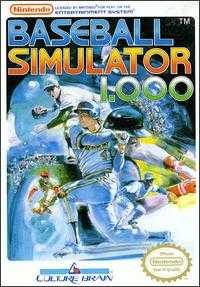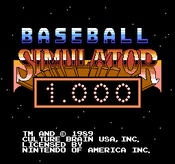Baseball Simulator 1.000
| Baseball Simulator 1.000 | |
|---|---|
 North American cover art | |
| Developer(s) | Culture Brain |
| Publisher(s) | Culture Brain |
| Platform(s) | Nintendo Entertainment System |
| Release date(s) | |
| Genre(s) | Baseball |
| Mode(s) | Single-player or double-player |
| Distribution | NES cartridge |
Baseball Simulator 1.000 (超人ウルトラベースボール, Choujin Ultra Baseball) is a baseball game released on the NES. It was released in 1989 in Japan, 1990 in North America.
Gameplay

In the game, there are four leagues available. The first two contain only normal teams, the third contains only ultra teams, and the fourth allows a player to create their own league from any mixture of normal and ultra teams. A player can either control a normal baseball team or an ultra baseball team with super hitting and pitching plays to boost their chances of winning. There are many ultra plays, but a few examples of this include:
- Ultra Hits
- "Tremor Hit"—The ball, after being hit, causes an earthquake on the first bounce, resulting in fielders being unable to move for a short period of time.
- "Missile Hit"—If a player on the opposite team gets in the way of a line drive, they will be driven back to the fence and smashed.
- "Spinner Hit"—Once the ball bounces, it becomes untouchable to the fielders until it stops moving.
- Ultra Pitches
- "Iron Ball"—The pitched ball becomes a lead cannonball in midair, making it almost impossible to hit without the batter using an ultra play. On rare occasions this pitch is hittable using an ordinary swing.
- "Fire Ball"—A super-fast fastball, which would regularly reach close to 120 miles per hour (190 km/h).
- "Photon Ball"—An extremely fast pitch (around 1,000 miles per hour (1,600 km/h)), almost always guaranteeing a strike due to low reaction time, or due to breaking the bat on impact.
Each Ultra play uses a certain amount of points. Ultra points are limited and when they are all used up no more ultra plays can be performed. Some Ultra Pitches provide humorous results, such as causing the batter to spin around several times and get dizzy from a strike, or causing the batter to explode when hit by the pitch. Both the Photon Ball and the Iron Ball cause batter explosion when "beaned". This is, however, simply used for comedic effect, as the batters are then granted a free base and are still playable.
There are also some Ultra Upgrades, for outfielders and batters. These cost more points to assign, but become intrinsic effects, and do not cost points to use.
- Ultra outfielder Upgrades
- "Harvester"—Allows the equipped outfielder to catch the missile and spinner hits.
- "Super Jump"—Allows the equipped outfielder to jump high into the air and catch hits that would normally be home runs.
- Ultra Batter Upgrades
- "Sprinter"—Makes the batter run super-fast. While this is good if there is no player ahead of the runner, it can work against them if there is someone in their way, as they have to wait for the other person to get out of the way before they can advance to the next base. While they can outrun most pitches, if trapped between bases, they can be tagged out.
Within Baseball Simulator 1.000, there is an exhibition mode, a regular season mode, and a team edit mode that allows the player to make his own players to form a customized baseball team.
A magic number appears during the regular season, telling the leading team how many victories they have to make until they are assured the pennant.
A season can be 5, 30, 60, 120, or 165 games. Out of the 18 possible teams, only six teams can be used in a division/league during the season. It is possible to have normal and ultra teams in the same league. However, there are no playoffs for the top two teams. Whoever wins the division is the champion.
Also, hitters on first place teams tend to lose their power when their team holds a five game lead or higher over the second place team. The same goes for the pitchers and their stamina. This also happens when the team that is playing at a particular time is tied with another team for first place.
Baseball Simulator series
These baseball titles included some form of "Super League" where pitchers and batters would have special abilities.
- Baseball Simulator 1.000 (1989, NES), also known as Choujin Ultra Baseball
- Super Baseball Simulator 1.000 (1991, Super NES), also known as Super Ultra Baseball
- Ultra Baseball Jitsumeiban (1992, SNES) NPB licensed.
- Super Ultra Baseball 2 (1994, SNES)
- Ultra Baseball Jitsumeiban 2 (1994, SNES) NPB licensed.
- Ultra Baseball Jitsumeiban 3 (1995, SNES) NPB licensed.
Reception
Electronic Gaming Monthly awarded it "Best Sports-Themed Video Game" in their 1989 awards issue, giving it "top honors ... [for] taking liberty with the sport itself."[2] Allgame gave the game 3.5 out of 5.[3]
References
- ↑ "Release information". GameFAQs. Retrieved 2008-10-29.
- ↑ "Best and Worst of 1989", Electronic Gaming Monthly 1 (5), December 1989: 17–24
- ↑ "Rating information". allgame. Retrieved 2012-10-16.
External links
- Baseball Simulator 1.000 at MobyGames
- Choujin - Ultra Baseball at SuperFamicom.org